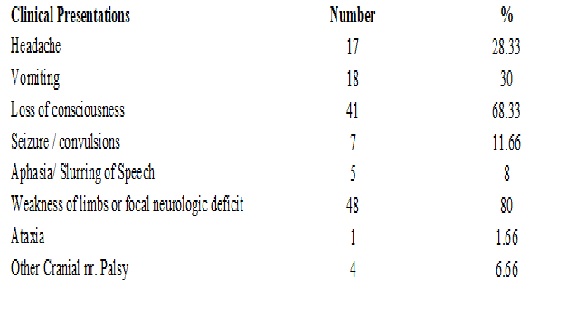Clinical outcome in cases of hypertensive intra-cerebral haemorrhage in relation to size of haemorrhage
Abstract
Introduction: Stroke is amongst the leading causes of death exceeded only by heart disease and cancer. Those who survive are usually left with permanent disability. Cerebral infarction is responsible for about 80 percent of all strokes, primary intra-cerebral haemorrhage for 10 percent, subarachnoid haemorrhage for 5 percent and 5 percent cases are due to uncertain causes. Predictors of prognosis in primary intraparenchymal haemorrhage have been evaluated in numerous studies.
Objective: To observed the effect of different sizes of hematoma and utilizing them, if feasible as a marker of prognostic significance.
Material and methods: In this study we observed 60 patients from the time of admission till 30th day in various wards of Department of Medicine RIMS with hypertensive intra-cerebral haemorrhage, during the period of 2008-2009. A simple method of measuring the volume of haematoma (in cc) on the CT scan is by using the following formula: A*B*C A = longest diameter of the haematoma (in cm.), B = Diameter perpendicular to A (in cm.), C = Height (in cm) which is measured by No. of slices showing the haematoma x thickness of each slide.
Result: Total 60 patient were taken into study out of which 33(55%) were alive and 27(45%) were dead in 30 days follow up. In our study, 38 were male and 22 were female out of 38 male 22(66.66%) were alive and 16 (59.2%) dead and in 22 female 11(33.33%) were alive and 11 (40.7%) were dead. Outcome with volume of ICH using the χ2 had shown significant correlation (p < 0.005) with GCS at the time stroke onset (P<0.01), IVH/VE (P<0.01), midline shift test (P<0.01), B.P. at the time of admission (P<0.01).
Conclusion: In these study patients with hematoma volume exceeds 60 cm3, the mortality was 100%. Mean volume of hematoma in our study was 35.21 cm3.
Downloads
References
WHO. The Global Burden of Disease: 2004 Update. Geneva, Switzerland: WHO; 2008.
Fewel ME, Thompson BG Jr, Hoff JT. Spontaneous intracerebral hemorrhage: a review. Neurosurg Focus. 2003 Oct 15;15(4):E1.
Massaro AR, Sacco RL, Mohr JP, et al. Clinical discriminators of lobar and deep hemorrhages: the Stroke Data Bank. Neurology. 1991 Dec;41(12):1881-5.
Broderick JP, Brott TG, Duldner JE, et al. Volume of intracerebral hemorrhage. A powerful and easy-to-use predictor of 30-day mortality. Stroke. 1993 Jul;24(7):987-93.
Kase CS, Williams JP, Wyatt DA, Mohr JP. Lobar intracerebral hematomas: clinical and CT analysis of 22 cases. Neurology. 1982;32:1146–1150.
Helweg-Larsen S, Sommer W, Strange P, Lester J, Boysen G: Prognosis for patients treated conservatively for spontaneous intracerebral hematomas. Stroke 1984;15:1045-1048.
Bolander HG, Kourtopoulos H, Liliequist B, Wittboldt S. Treatment of spontaneous intracerebral haemorrhage: A retrospective analysis of 74 consecutive cases with special reference to computer tomographic data. Ada Neurochir (Wien) 1983;67:19-28.
Tuhrim S, Horowitz DR, Sacher M, et al. Volume of ventricular blood is an important determinant of outcome in supratentorial intracerebral hemorrhage. Crit Care Med. 1999 Mar;27(3):617-21.
Goldstein JN, Fazen LE, Snider R, et al. Contrast extravasation on CT angiography predicts hematoma expansion in intracerebral hemorrhage. Neurology. 2007 Mar 20;68(12):889-94. DOI: https://doi.org/10.1212/01.wnl.0000257087.22852.21.



 OAI - Open Archives Initiative
OAI - Open Archives Initiative


